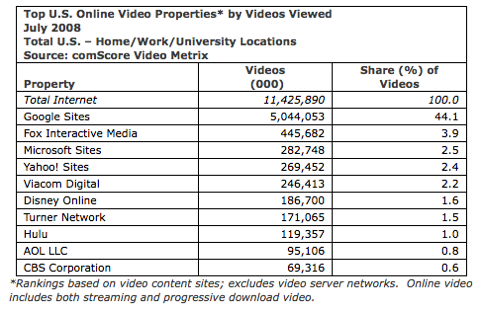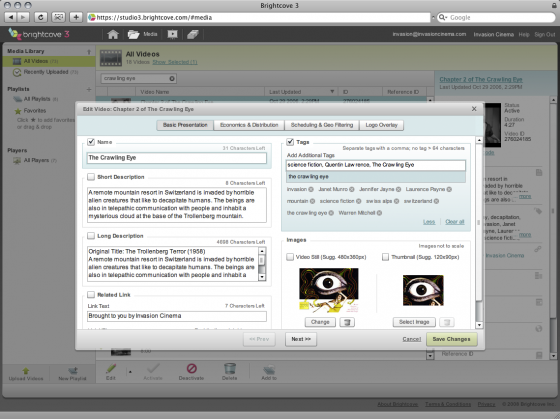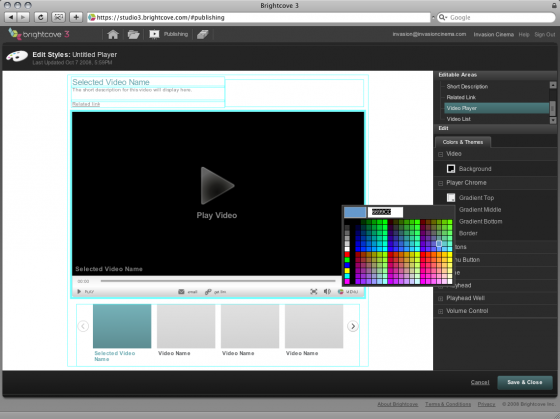
A couple days ago, we posted some leaked screenshots of Brightcove 3, the completely gutted and rebuilt Web video platform from Brightcove that is launching on Tuesday. I was able to catch up with Brightcove CEO Jeremy Allaire, who gave me an update on the company and took me through all the changes in the service.
Brightcove is a Web video publishing platform that has raised $91 million and boasts hundreds of major media brands as its customers, including Dow Jones, Showtime (Dexter, The Tudors), Lifetime, AMC (Mad Men), Time magazine, and the New York Times. TV networks, magazines, newspapers, and music companies all use Brightcove to distribute and manage video on their sites and across the Web. Increasingly, so do big corporations like Sun Microsystems, universities like NYU, and political organizations like the Obama campaign.
Allaire says that, collectively, his customers are distributing Web video at the rate of “several hundred million streams per month,” which would make Brightcove one of the top ten video networks. It would still be well below No. 1 YouTube, which is streaming five billion videos a month, but perhaps within spitting distance of No. 2 Fox Interactive/MySpace (446 million streams) or No. 3 Microsoft (286 million streams).

As far as Brightcove’s financial situation goes, Allaire would only say:
We are not profitable, but our burn rate continues to go down. We don’t expect to have to raise additional money based on our growth.
The Boston-based company now has 160 employees, and is spreading internationally. Europe now represents 20 percent of revenues and 34 percent of bookings, up from zero twelve months ago. And Alliare launched a separately capitalized Japanese subsidiary in May.
With Brightcove 3, the company is introducing a streamlined user interface and a whole new set of capabilities. These include a new markup language for creating video players called the Brightcove Experience Markup Language (BEML), new APIs for customers and developers, and intelligent streaming technology that dynamically changes the video quality based on the viewer’s device and bandwith limitations.
Here is a summary of the new features in Brightcove 3:
- Custom Players. New APIs allow deeper customization of the Brightcove video players and viewing experience. The Brightcove Experience Markup Language makes it easy for any Web developer who knows HTML to create sophisticated stylings, social tools, and video-player navigation options.
- Pricing. Brightcove is going from one flat-rate pricing to three different tiers (basic, professional, and enterprise). Subscriptions start at thousands of dollars per year and go up to hundreds of thousands for enterprise customers.
- Dynamic Delivery. Each video stream is optimized on the fly, based on a viewer’s bandwidth and factors such as the size of the player. Brightcove 3 automatically creates multiple renditions of each video appropriate for everything from mobile to HD viewing.
- More APIs. Brightcove already has APIs that let developers customize its video player. Now it is opening that up to developers who want to write plug-ins for social commentary tools (JS-KIT did this), contextual advertising, or analytics. The company is also releasing syndication APIs for controlling the advertising for each video no matter where it appears. And its Brightcove Media APIs will make each video visible to search engines and make it easier to add related videos, and other contextual information. Each Brightcove video will now have its own unique URL. The Media API will allow publishers to extact programming information from the videos so they can insert it into the HTML of each page.
On this last point, Allaire says:
YouTube has taught us all this lesson. Every video has its own page that has 20 different ways to the next video.
And in the face of the overwhelming dominance of YouTube, how do you see Brightcove videos there? Allaire’s answer:
You don’t and you don’t need to. You find it in Google. Video is a media type. It is a powerful medium for communications. Broadband internet will drive video. Traffic will flow across Websites.
Maybe some day, but right now it still looks like a winner-take-all game. Allaire thinks he can change that.
Here is an interview with Allaire about Brightcove 3 from Beet.TV:
http://services.brightcove.com/services/viewer/federated_f8/271525782

